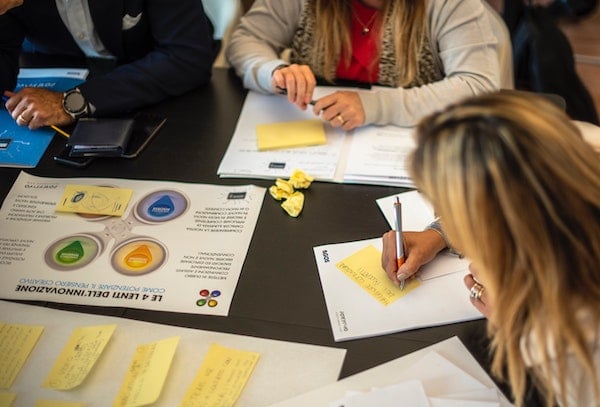Published on
Ideation to Implementation: Engaging Faculty to Lead Innovation

Before the COVID-19 global pandemic, RCC had a negligible but steady approach to enhancing online course offerings. The institutional focus was primarily on live in-class instruction. Although the online education team rigorously created pathways to asynchronous course developments and training outside the go-to champions, institutional momentum was not there. For example, faculty rooted in Collaborative Online International Learning (COIL) also led the charge in developing asynchronous courses.
Technology integration in courses was lacking overall. The percentage of courses administered through our learning management system (LMS)—including faculty using the LMS for simple functions such as grade reporting, syllabus, and asynchronous, did not surmount fifty percent. The traditional modes of classroom environment were consistent—such as heavy use of grade books and face-to-face live instruction. The culture was steadfast; many programs and faculty did not have the desire or see the need to increase their online presence.
The Opportunity
Serving as the inaugural Associate Provost for Academic Innovation, Online Education, and Global Opportunities at a community college, my primary objectives included activities to scale the reach of online education and academic technology. I want to focus on a few strategic decisions and discuss specific challenges that set the tone of my tenure in this role and fostered the creation of a collaborative faculty-engaged community that enhanced innovation.
My grandmother migrated to the United States as an adult and made a life for her kids and grandchildren. Now here was a woman with less than a third-grade level of education, but she knew education was the great equalizer. Growing up, she would always teach lessons through proverbial sayings, one of which is at the core of my leadership style: “When you walk into a room and see everyone hopping on one foot before you put both of your feet on the ground, hop on one foot as well.” — Marcia Sanon.
1. Learning: Gather information to understand WHO, WHAT, WHY is happening.
I took that to mean that one must first understand before making any changes. Leading with appreciation, I needed to understand the landscape to be the most effective in this work. My first strategic action was facilitating an institution-wide technology audit within the first quarter. The purpose of the survey was to inventory the various software and hardware used in our classrooms and what goals the faculty tried to achieve by using them.
Like most community colleges, our teams wear multiple hats, and resources are scarce. Automation was a viable option to address the frequently presented concerns to stretch our capacity. We committed resources to creating training videos to alleviate the issues caused by limited time and support personnel. The global pandemic would hit, and fortunately these two significant initiatives served as a solid foundation for our response to COVID-19.
2. Promoting: Create opportunities to celebrate and champion people and processes that have been working.
Weaving the technology audit and enhancing the training program were instrumental in navigating our new reality. Understanding which faculty members on campus, even if a limited number, were familiar with various technology tools and resources facilitated the creation of a champion model and peer database. We launched a Lunch and Learn series during the pandemic and shared tips and tools for online education and educational technology. The survey allowed us to maximize participation. In addition to the sessions led by the Academic Technology Team, we also included a peer-centric model that allowed faculty to share their experiences and best practices with their colleagues.
As mentioned, many faculty did not want to teach online or heavily integrate technology into their classroom environment. Attitudes began to shift when they saw their peers highlight and showcase how various tech tools have amplified their classroom experience.
The moment we decided to create video support training before the pandemic could only be divine intervention. Automation was part of our strategic plan, but the timing was impeccable. By March 18, 2020, we created and published five asynchronous training videos to support LMS faculty. The impetus behind these videos was to mitigate the use of our education technology team as first responders to every technology concern. For example, during my first few weeks on the job, I observed our LMS technology lead spend hours daily repeating the same information to multiple faculty. To maximize their contribution to the team and eliminate repetitive workflow, in-house training videos were created to allow the education technology team to grow their work capacity. Further, providing the foundation for faculty to own their learning in this space.
Presently, we have dozens of training modules and Lunch and Learn workshops. Other institutional departments have even adopted the Lunch and Learn model to share information.
3. Investing: Facilitate institutional decisions that support creating and growing areas where faculty are engaged and that yield positive returns for their school.
The commitment to excellence and the contributions the Online Education and Academic Technology Team has made have proven invaluable. The institution has recognized the need for continued growth and investment in the area. The online course portfolio has grown to include over 200 courses and 25 online degree programs, with an increase of online faculty from less than 30% to over 88%. I am proud to announce that this work supported the case to expand the department personnel and has added a dean position. This position would never have been conceived if not for the team’s strategic vision and implementation. As a pre-pandemic example from my initial observations: I requested that the education technology team track all their contact instances with faculty. We learned that there could be 68 service instances in a week, but the context revolved around the same fundamental issues. These data supported the subject focus for the initial training videos such as using the LMS grade book.
During the pandemic, the team continued to track their support instances. By fall 2020, we were at 745 contact points. The rapid shift to remote or online instruction due to the pandemic drastically increased the level of engagement and attention required from education technology. Having already implemented a tracking system, we could use data to inform the decision that resources needed to be reallocated to adjust the institution’s demands and support the education technology department’s growth.
The mindset shifts necessary for this work to happen were not easy. Firstly, understanding the position of the education technology team, who were accustomed to a different workflow. My initial request to track their contact points came off as an attempt to micromanage their efforts. I spent reasonable time with the director and coordinator level-setting and dreaming before engaging in the tactical part of getting there. Their acceptance of what their role could become if they had more time and resources was imperative to them wanting to do the mundane tasks of hopefully building the case of support to enlist more resources and free up their time.
Committing to Faculty Engagement
Faculty engagement is at the heart of any successful initiative. Leveraging and celebrating faculty to enlist their colleagues were essential factors. Faculty were enticed to be part of the change by their community peers. The pandemic also built an authentic urgency that encouraged faculty to model behaviors with which others found success—for example, integrating voice recordings on slides to increase student engagement.
The philosophy used to curate innovation in our community stems from an appreciation framework and core belief that innovation is about the little things that help make things work a lot better—hence, innovation can be everywhere.
I am incredibly blessed and honored that they trusted me and my vision to carry out this work. Most recently, the State University of New York honored me with the 2022 Award for Administrative Excellence in Leadership in Instruction and Technology. This is just the beginning.
About the College:
Rockland Community College, State University of New York (RCC), offers a safe, supportive learning environment for thousands of students from diverse backgrounds. Thanks to our affordable tuition, students can save $100,000 on college education by starting at RCC and transferring to outstanding four-year colleges. Our award-winning faculty works closely with students to ensure their success, and we have numerous student services to help students meet their goals. RCC also serves as a unique and essential resource for the community. Our cultural offerings attract thousands of community members, and the business community turns to RCC for workforce training and development.
Author Perspective: Administrator
Author Perspective: Community College


